| Name | Uncut
weight
(carat) | Cut
weight
(carat) | Color | Country/region of origin | Description | Image |
| 26th Congress of the Communist Party of the Soviet Union[6] [7] | 342.57 | | yellow | Russia / USSR | Mined at the Mir kimberlitic pipe (Yakutia, Russia) in 1980. It is the largest gem diamond ever found in Russia or the former USSR. It is the size of a pigeon's egg and is currently kept (as of 2016) in the Russian Diamond Fund (Moscow Kremlin.) | — |
| 4 February Stone (The Art of de GRISOGONO)[8] | 404.2 | 163.41[9] | white | Angola | 27th largest white diamond found (at that time), and largest diamond from Angola, the 404 carats (80.8 g) 4 February diamond was found in early February 2016, and was cut into a 163 carats (32.6 g) flawless D-color emerald-shaped stone. | — |
| Akbar Shah | 116 | 71.7 | colorless | India | An Indian diamond which became famous during the days of the Mughal Empire. A diamond with a roughly pear-shaped outline and random faceting, including two Persian inscriptions, the first reading "Shah Akbar, the Grand King, 1028 A.H." (the letters mean Anno Hegirae). The second inscription read "To the Lord of Two Worlds, 1039 A.H. Shah Jehan". The diamond was reportedly part of the original Peacock Throne. Purchased in 1886 in Istanbul by London merchant George Blogg, who re-cut it from 116 carats (23.2 g) to a pear-shape of 71.70 carats (14.340 g), thus destroying the historic inscriptions. Blogg sold the stone in 1887 to Malhar Rao Gaekwad of Baroda, India who was the last known owner and the stone's whereabouts are presently unknown. | — |
| Alexander Pushkin[6] [7] | 320.65 | | colorless | Russia / USSR | Mined at the Udachnaya kimberlitic pipe (Yakutia, Russia) in 1989. It is the second largest gem diamond ever found in Russia or the former USSR and is currently kept (as of 2016) in the Russian Diamond Fund (Moscow Kremlin.) | — |
| Allnatt Diamond | | 101.29 | yellow | South Africa (disputed) | A 101.29-carat (20.258 g) antique cushion-shaped brilliant fancy vivid yellow diamond which is believed to have been found in the Premier mine in the South African Republic. It got the name Allnatt[10] after one of its owners, Major Alfred Ernest Allnatt. The diamond was sold for a little more than $3 million at Christie's auction in Geneva in May 1996. | 
Allnatt Diamond |
| Amarillo Starlight | 16.37 | 7.54 | colorless | United States | The largest diamond found by a park visitor in the Crater of Diamonds State Park in Arkansas since 1972, when it was established as a state park. It was found by W. W. Johnson of Amarillo, Texas in 1975 and was a 16.37 carats (3.27 g) white diamond, but it has since been cut into a 7.54 carats (1,510 mg) marquise shape. | — |
| Amsterdam Diamond | | 33.74 | black | Africa | A 33.74 carat (6.748 g) pear-shaped black diamond which sold for $352,000 in 2001. | — |
| Archduke Joseph | 78.54 | 76.02 | colorless | India | Historical cushion-shaped, D colour, internally flawless Golconda diamond, sold on 13 November 2012 by Christies to an anonymous buyer for US$21.4M.[11] | — |
| Argyle Pink Jubilee | 12.76 | 8.01 | pink | Australia | Argyle Pink Jubilee[12] is the largest pink diamond ever found in Australia weighing 12.76 carats. The diamond was found in Western Australia in Argyle Mine who is the largest producer of pink diamonds in the world. | — |
| Ashberg Diamond | | 102.48 | amber | South Africa | 102.48 carats (20.496 g) | — |
| Aurora Butterfly of Peace | | | | Russia South Africa Brazil Australia | A display of 240 fancy-colored diamonds. | 
The 240 diamonds |
| Aurora Pyramid of Hope | | | | | A display of 296 diamonds of natural colors. | 
The 296 diamonds |
| Beau Sancy | | 34.98 | colorless | India | A 34.98-carat (6.996 g)[13] pear-shaped diamond, which sold for US$10 million in 2012.[14] Not to be confused with the Sancy. | 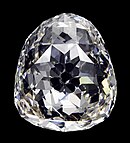
Beau Sancy |
| Black Orlov | 195 | 67.5 | black | India | A 67.50-carat (13.500 g) cushion-cut black diamond, also called the Eye of Brahma Diamond. |
Orlov Diamond |
| Blue Moon of Josephine Diamond | 29.6 | 12.03 | blue | South Africa | Found in the Cullinan mine in 2014, cushion-shaped, and originally named the 'Blue Moon' diamond. Purchased for a record breaking 48.6 million Swiss francs (US48.4 million) at a Sotheby's auction in Geneva on 11 November 2015 by the Hong Kong tycoon Joseph Lau. He renamed it "The Blue Moon of Josephine" in honor of his daughter. The previous day he had bought the 'Sweet Josephine' diamond for her.[15] [16] |
Blue Moon of Josephine Diamond |
| Briolette of India | | 90.38 | colorless | India (See article) | 90.38 carats (18.076 g) - Cut by Cartier around 1910. | — |
| Brunswick Blue | | 44.25 | blue | | May be a part of the Tavernier Blue.[17] | — |
| Centenary Diamond | 599 | 273.85 | colorless | South Africa | 273.85 carats (54.770 g), modified heart-shaped brilliant, the world's largest colorless (grade D), flawless diamond. | — |
| Chloe Diamond | | 84.37 | colorless | Angola | Sold in November 2007 at Sotheby's in Geneva to Georges Marciano of the Guess clothing line for 18.2 million SFr, the second-highest price ever paid for a diamond at auction.[18] | — |
| Cora Sun-Drop Diamond | | 110.03 | yellow | South Africa | Largest known pear-shape fancy vivid yellow diamond, found in South-Africa[19] [20] | — |
| Creator[6] [7] | 298.48 | | colored | Russia | Found in a placer mining factory in the Lower Lena River area, Yakutia, in 2004. It is the third largest gem diamond ever found in Russia or the former USSR and is currently kept (as of 2016) in the Russian Diamond Fund (Moscow Kremlin.) | — |
| Cross of Asia | 280 | 79.12 | yellow | South Africa | Discovered in 1902 at the Jagersfontein Mine as a 280-carat (56 g) crystal. The first cut was to 142 carats (28.4 g); it was then cut three more times until, in 1993, it was a 79.12 carats (15.824 g) radiant-cut with table facets that resemble a Maltese cross.[21] | — |
| Cullinan Diamond | 3106.75 | | colorless | South Africa | Discovered in 1905, the Cullinan is, at 3106.75 carats (621.35 g), the largest rough gem-quality diamond ever found. It was cut into 105 diamonds including the Cullinan I or the Great Star of Africa, 530.2 carats (106.04 g), and the Cullinan II or the Lesser Star of Africa, 317.4 carats (63.48 g), both of which are now part of the British Crown Jewels. |  The uncut diamond. |
| Cullinan I | 3106.75 | 530.4 | colorless | South Africa | The largest stone obtained from Cullinan diamond. Cullinan I or Great Star of Africa with weight of 530.4 carats it is the second largest cut diamond in the world. Currently located in the head of the Sceptre of the British Crown Jewels British Royal family. |  The cut diamond outside of the Sovereign Sceptre |
| Cullinan II | 3106.75 | 317.4 | colorless | South Africa | The second largest stone obtained from Cullinan diamond. Cullinan II or Second Star of Africa with weight of 317.4 carats is also one of the largest cut diamonds in the world. As Cullinan I, it is also in the British crown jewels located in the Imperial State Crown British Royal family. | — |
| Cullinan III | 3106.75 | 94.4 | colorless | South Africa | The third largest stone obtained from Cullinan diamond. Cullinan III or Lesser Star of Africa with weight of 94.4 carats is also part of the British crown jewels British Royal family. No longer mounted in any of the crowns, it is frequently worn in combination with Cullinan IV as a brooch | — |
| Daria-i-Noor | | 182 | pink | India | The largest pink diamond in the world, approximately 182 carats (36.4 g), originally from India but now part of Iranian Crown Jewels. Its exact weight is not known; 182 carats (36.4 g) is an estimate. | 
The Daria-i-Noor |
| DeBeers Diamond | 440 | 234.5 | | South Africa | Discovered in 1888[22] | - |
| Deepdene | | 104.52 | yellow | South Africa | Widely considered to be the largest artificially irradiated diamond in the world, at 104.52 carats (20.904 g). | — |
| DeYoung Red Diamond | | 5.03 | brownish-red | South Africa | Weighing 5.03 carats (1.006 g), the third-largest known red diamond GIA graded as "fancy dark reddish brown", was bought in a flea market on a hatpin by Sidney deYoung a prominent Boston estate jewelry merchant. It was donated by him to the Smithsonian Institution National Museum of Natural History. | 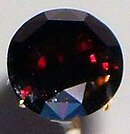 |
| Dresden Green Diamond | | 41 | green | India | 41-carat (8.2 g) antique pear-shaped brilliant - its color is the result of natural irradiation | 
Dresden Green (glass replica) |
| Earth Star Diamond | 248.9 | 111.59 | brown | South Africa | a 111.59-carat (22.318 g) pear-shaped diamond with a strong coffee-like brown color. | — |
| Empress Eugénie (diamond) | ~100 | 51 | | Brazil | 51-carat (10.2 g) oval-shaped brilliant diamond, perfectly cut | — |
| English Dresden | 119.5 | 76.5 | | Brazil | Found in 1857[23] | — |
| Esperanza Diamond | 8.52 | 4.602 | D IF | United States | Discovered in 2015, it is the 5th largest diamond ever discovered at the Crater of Diamonds State Park, Arkansas Identified as a Type IIa crystal, the 8.52 carat diamond was cut and polished by Mike Botha into a custom-designed 4.605 carat Triolette shape during a week long event in North Little Rock and was graded a D IF, 0 Polish & 0 Symmetry by the American Gem Society Laboratories- making it the most valuable American diamond. | 
Esperanza Diamond |
| Eureka Diamond | 21.25 | 10.73 | yellow-brown | South Africa | the first diamond found in South Africa, a yellow-brown 21.25-carat (4.250 g) stone (before cutting) resulting in a finished diamond 10.73 carats (2.146 g) | — |
| Excelsior Diamond | 970 | | colorless | South Africa | The largest known diamond in the world prior to the Cullinan at 970 carats (194 g), it was later cut into 10 pieces of various sizes (13–68 carats) | — |
| Florentine Diamond | | 137.27 | yellow | India | A lost diamond, light yellow with a weight of 137.27 carats (27.45 g). | 
Florentine Diamond (glass replica) |
| Fortuna Diamond | | 26.29 | colourless | India | A cushion-shaped diamond set into a pendant with a 0.75ct Argyle pink diamond, and 4.5 carats of Argyle pinks. The stone has been given a name to fit its history, rarity and setting – the Fortuna Diamond. Classified as a Type 2A[24] with a colour grade of I and clarity grade of VVS2.[25]
| — |
| French Blue (or Tavernier Blue before its cut) | 112 | 69 | blue | India | (Lost during French Revolution) Largest blue diamond allegedly discovered up to this date before its cut, it was faceted by Jean Pittan to be the main French Crown Jewel. Lost, and then almost certainly cut into the Hope Diamond. | — |
| Golden Dawn | 133 | 61.5 | | South Africa / Vaal River | Found in 1913, cut into an American cut brilliant[26] | — |
| Golden Eye Diamond | | 43.51 | yellow | South Africa | A large, radiant-cut fancy intense yellow diamond (43.5 carats). | — |
| Golden Jubilee Diamond | 755.5 | 545.67 | yellow-brown | South Africa | The Unnamed Brown as originally named, the Golden Jubilee[27] is the largest faceted diamond ever cut at 545.67 carats (109.13 g), outweighing Cullinan I by 15.27 carats | — |
| Graff Lesedi La Rona | 1111 | 302.37 | colourless | Botswana | A 302.37 carat D color high-clarity emerald cut diamond. It is the main stone cut from the Lesedi La Rona, bought by Graff in 2017 and cut in 2019. The cutting of the rough stone also produced 66 smaller stones. According to Graff, the stone is the "largest highest clarity, highest color diamond ever graded by the Gemological Institute of America (GIA)".[28] [29] | — |
| Graff Pink | | 24.78 | pink | India | 24.78-carat (4.956 g) A 24.78-carat Fancy Intense Pink diamond and, until the sale of the Sweet Josephine diamond in November 2015, it was the most expensive jewel ever sold at auction. Previously owned by Harry Winston and an unnamed private collector, and bought by Laurence Graff (November 2010).[30] | — |
| Great Chrysanthemum Diamond | | 104.15 | orange-brown | South Africa | 104.15 carats (20.830 g) | — |
| Great Mogul Diamond | 780 | 280 | | India | Fabled 280-carat (56 g) mogul-cut diamond, now lost, although presumed by historians to have been re-cut as the Orlov. | 
Great Mogul Diamond (replica) |
| Gruosi Diamond | | 115.34 | black | India | A heart-shaped black diamond, weighing 115.34 carats (23.068 g). | — |
| Heart of Eternity Diamond | | 27.64 | blue | South Africa | Perhaps the largest fancy vivid blue, weighing 27.64 carats (5.528 g). | — |
| Hope Diamond | 112 | 45.52 | blue | India | 45.52 carats (9.104 g), is a Fancy Dark Grayish-Blue diamond and supposedly cursed. Almost certainly cut from the French Blue Diamond. Part of the Smithsonian Collection. | 
The Hope Diamond |
| Hortensia Diamond | | 20 | peach | India | Peach (slightly orangey pink) color, formerly part of the French Crown Jewels. Displayed in the Louvre. | — |
| Incomparable Diamond | 890 | 407.48 | brownish-yellow | Democratic Republic of Congo | A brownish-yellow diamond of 407.48 carats (81.496 g) cut from an 890 carat (178 g) rough diamond of the same name - it appeared on eBay in 2002. Internally Flawless clarity. Several other smaller diamonds were also cut from the crystal. | — |
| Jacob Diamond | | 184.5 | colorless | India | Cushion cut weighing 184.5 carats (36.90 g) also known as Imperial Diamond & Victoria Diamond. | — |
| Jagersfontein Diamond | 215 | | | South Africa | Found in 1881 at the Jagersfontein Mine[31] | — |
| The Jane Seymour | | 2.08 | blue | Russia | Cushion cut weighing 2.08 carats (416 mg) | — |
| Jones Diamond | | 34.48 | blueish-white | United States | Weighing 34.48 carats (6.896 g), found in West Virginia by the Jones family. Also known as the Punch Jones Diamond. | — |
| Jubilee Diamond | 650.8 | 245.3 | colorless | South Africa | Originally known as the Reitz Diamond; perhaps the sixth-largest in the world at 245.35 carats (49.070 g). | — |
| Kazanjian Red Diamond | 35 | 5.05 | brownish-red | South Africa | A 5.05-carat (1.010 g) Emerald-cut red diamond formerly known simply as "Red Diamond". This is the second-largest known red diamond. It was cut from a 35-carat (7.0 g) piece of boart discovered near Lichtenburg, South Africa. It reappeared in 2007 after a 37-year absence from sight, and was purchased by Kazanjian Brothers Inc. | — |
| Koh-i-Noor | 793 | 105.6 | colorless | India | A 105.6 carat (21.6 g) white of Indian origin-(Golconda diamonds), with a long and turbulent history and a good deal of legend surrounding it. After belonging to Kakatiya, Delhi Sultante, Mughal, Persian, Afghan and Sikh rulers, it was surrendered in the 1849 Treaty of Lahore to Queen Victoria. It was recut from 191 ct, to its current size, and was part of the Crown of Queen Elizabeth the Queen Mother until her death in 2002. It is now on display in the Jewel House at the Tower of London | 
Koh-i-noor (replica) |
| Koi Diamond | | 32+ | white, orange and various | Congo | The colors of this sole and unique 32+ carat diamond evokes the well-known Koi fish legend and sacred symbolism cherished by East Asians. The graduations of color of white, orange, light yellow, darkblue and black colors in this diamond are reminiscent of ancient Chinese brush painting. The Koi Diamond has been certified by the GIA (Gemological Institute of America). | 
The Koi Diamond |
| Lesotho Legend | 910 | | D (colorless) Type IIa | Lesotho | Largest diamond yet found at the Letšeng mine. Sold in March 2018 for $40 million to an unknown buyer in Antwerp, Belgium.[32] [33] [34] | — |
| Lesotho Brown | 601 | 71.73 | pale brown | Lesotho | Was a stone originally 601 carats (120.2 g) with the largest stone 71.73 carats (14.346 g) after cutting. | — |
| Lesotho Promise | 603 | 75 | colorless | Lesotho | Is the 15th-largest diamond, the tenth-largest white diamond, and the largest diamond to be found in 13 years. The original stone was 603 carats (120.6 g), although the largest diamond after the cutting was 75 carats (15.0 g). | — |
| Martian Pink | | 12.04 | pink | South Africa | Named by American jeweler Ronald Winston in 1976. Sold by auction in May 2012 for US$17 million, "the largest round fancy intense pink diamond to ever go under the hammer", according to Christie's.[35] | — |
| Matryoshka | 0.62 | | colorless | Russia | The Matryoshka is a unique diamond with another diamond moving freely inside. This is the first and only such diamond in the entire history of world diamond mining until October 2019. | — |
| Millennium Star | 777 | 203.04 | colorless | Democratic Republic of Congo | At 203.04 carats (40.608 g), this is the second-largest colorless (grade D), flawless diamond. | — |
| Moon of Baroda | 25.95 | 24.04 | yellow | India | Moon of Baroda[36] is pear-shape 24.04 carats (4.808 g) diamond and it was discovered in Vadodara (Baroda) in India. | — |
| Moussaieff Red Diamond | 13 | 5.11 | red | Brazil | The largest known red diamond, at 5.11 carats (1.022 g). | — |
| Nassak Diamond | 89 | 43.38 | blue-white | India | An emerald-cut of 43.38 carats (8.676 g), previously a triangular brilliant of about 89 carats. | — |
| Nizam Diamond | | 340 | colorless | India | Reportedly 340 carats (68 g). Possibly a large colorless topaz. Whereabouts unknown. | — |
| Noor-ol-Ain Diamond | | 60 | pink | India | Around 60 carats (12 g) originally from India but now part of the Iranian crown jewels. | 
Noor-ol-Ain |
| Ocean Dream Diamond | | 5.51 | blue-green | Central Africa | The only known natural Fancy Deep Blue-Green, and weighs 5.51 carats (1.102 g). | — |
| Oppenheimer Blue | | 14.62 | blue | South Africa | Became the most expensive diamond in the world at the time of its sale in May 2016, selling for $50.6m (£34.7m). | — |
| Oppenheimer Diamond | 253.7 | | yellow | South Africa | One of the largest gem-quality uncut diamonds in the world, at 253.7 carats (50.74 g). | 
Oppenheimer Diamond |
| Orlov | | 190 | colorless | India | An Indian mogul cut rumored to have served as the eye of a Hindu statue, and currently is part of the Kremlin diamond fund, weighing approximately 190 carats (38 g). | 
Orlov |
| Paragon | | 137.82 | colorless | Brazil | A shield-shaped diamond of 137.82 carats.[37] | — |
| Pigot Diamond | 100 (est.) | 47.38 | colorless | India | A oval brilliant, once the largest diamond in England. Sold by lottery in 1801, auctioned by Christie's in 1802, current whereabouts unknown although a popular legend is that it was destroyed. | — |
| Pink Legacy | | 18.96 | pink | South Africa | The world's largest Fancy Vivid Pink. Sold by Christies on 13 November 2018, for 50.3 million Swiss francs ($50 million, £38.5 million), to Harry Winston, who renamed it the Winston Pink Legacy. Found in a South African mine around 100 years ago and has likely not been altered since it was first cut (rectangular cut) in 1920, and once owned by the Oppenheimer family, who ran De Beers.[38] | — |
| Pink Star | 132.50 | 59.60 | pink | Africa | Modified oval brilliant cut (step cut crown, brilliant pavilion), largest known fancy vivid pink, at 59.60 carats (11.920 g). Formerly known as the Steinmetz Pink, and the Pink Star.[39] Auctioned in Geneva by Sotheby's in 2013 for $83.187 million[40] | — |
| Pitt Diamond[41] | | | | | See Regent Diamond | — |
| Polar Star Diamond | | 41.28 | colorless | - | A colorless cushion-shaped stellar brilliant diamond weighing 41.28 carats (8.256 g). Known for its symmetry, and once owned by Napoleon's older brother, it disappeared after being sold to a Sri Lankan diamond merchant in 1980 for a then-record $4.6 million.[42] [43] | — |
| Portuguese Diamond | | 127.01 | pale yellow | Brazil | 127-carat (25.4 g) antique emerald cut with a pale yellow body color and very strong blue fluorescence. Part of the Smithsonian's collection. | 
Portuguese Diamond |
| Premier Rose Diamond | 353.9 | 137.0 | colorless | South Africa | 137.02-carat (27.4 g) stone cut from a 353.9-carat (70.8 g) rough gem of the same name. | — |
| Princie Diamond | | 34.65 | pink | India | Antique cushion-cut, fancy intense pink, natural color, VS2 clarity, type IIa, displays bright orangey-red fluorescence when exposed to ultraviolet light (G.I.A.'s lab data);[44] [45] discovered 300 years ago in the Golconda mines[46] | — |
| Pumpkin Diamond | | 5.54 | orange | Central African Republic | Perhaps the largest fancy vivid orange diamond (5.54 carats), modified cushion-shaped brilliant. | — |
| Raven Diamond | | 12.78 | black | - | Trilliant cut black diamond purchased in 2011. The Raven is currently in a private collection in upstate NY. | 
Raven Diamond |
| Regent Diamond | 410 | 140.64 | white with pale blue | India | Weights 140.64 carats (28.128 g), is cushion-shaped stellar brilliant cut, formerly belonging to Louis XV, Louis XVI, and Napoleon Bonaparte, it now resides in the Louvre. | 
Regent Diamond (1907 drawing) |
| Sancy | | 55.23 | pale yellow | India | A shield-shaped pale yellow diamond currently in the Louvre, weighing 55.23 carats (11.046 g). | 
Sancy (1907 drawing) |
| Sergio | 3150 | | carbonado | State of Bahia (Brazil) | Largest carbonado and largest rough diamond ever found.[47] [48] [49] Found in 1895. | — |
| Shah Diamond | | 88.7 | pale yellow | India | Very old pale yellow diamond (found approximately in 1450 in India) currently housed in the Diamond Fund in Kremlin, weighing 88.7 carats (17.74 g). | — |
| Sierra Leone diamond | 706 | | | Sierra Leone | The discovery was made by Pastor Emmanuel Momoh in an artisanal mine in the village of Koyadu in eastern Kono district in 2017 | — |
| Skull Star Diamond | | 52.4 | | | Pear-shaped pink diamond set in the forehead of Damien Hirst's For the Love of God sculpture.[50] | — |
| Spirit of de Grisogono Diamond | | 312 | black | Central African Republic | Mogul cut, 312 carats (62.4 g), the world's largest cut black diamond. | — |
| Spoonmaker's Diamond | | 86 | colorless | - | Circa 86-carat (17 g) diamond housed in Topkapı Palace in Istanbul. Also known as Kaşıkçı Elması | — |
| Star of the East | | 95 | colorless | India (disputed) | A 95-carat (19 g) stone once owned by Evalyn Walsh McLean of Washington, D.C., who also owned the Hope Diamond. It was also owned by King Farouk of Egypt, although he never settled the bill. | — |
| Star of Sierra Leone | 968.9 | various | colorless | Republic of Sierra Leone | Cut into smaller pieces, the largest of which is 53.96 carats (10.792 g). | 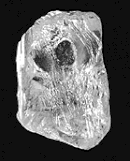
Star of Sierra Leone |
| Star of South Africa | 83.5 | 47.69 | colorless | South Africa | also known as the Dudley Diamond. This must not be confused with the Star of Africa. The Star of South Africa was the initial name given to this diamond, when it was purchased as an 83.5-carat (16.70 g) rough diamond. The diamond is a D-color, pear-shaped stellar brilliant cut stone, weighing 47.69 carats (9.538 g). | — |
| Star of the Season | | 100.10 | colorless | - | a 100.10-carat (20.020 g) pear-shaped D-color, Internally Flawless stone. At $16,548,750 US it held the world record for the highest price paid for a diamond at auction until the sale of the Wittelsbach-Graff diamond in 2008. | — |
| Star of the South | | 128.48 | light pinkish-brown | Brazil | Found in Brazil in 1853. Cartier is the last known owners of the diamond (mid-2000s). | 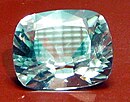
Star of the South (replica) |
| Strawn-Wagner Diamond | 3.03 | 1.09 | colorless | United States | A diamond which received a "perfect" 0/0/0 rating from the American Gem Society, weighing 3.03 carats (0.606 g) rough and 1.09 carats (0.218 g) cut. On exhibit at Crater of Diamonds State Park in Arkansas, where it was found in 1990. | — |
| Stuart or Holland Diamond | | 39.75 | light blue-green | | Pear shaped rose cut diamond. Bought in 1690 as a rough stone by Queen Mary II Stuart, wife of King William of Orange. Therefore, also referred to as the Holland diamond. Belongs to the Dutch Royal House. | — |
| Sweet Josephine Diamond | | 16.08 | fancy vivid pink | | The largest cushion-shaped stone classified in the elite "fancy vivid" category to ever come to auction. Owned by an American family of 15 years, it was sold at auction in November 2015 to Hong Kong billionaire Joseph Lau, and renamed by him the 'Sweet Josephine' after his daughter.[51] The next day he bought the 'Blue Moon of Josephine' diamond for her.[52] | — |
| Taylor-Burton Diamond | 241 | 68 | colorless | South Africa | Purchased by Richard Burton for his wife Elizabeth Taylor, weighing 68 carats (13.6 g). | — |
| Tereshchenko diamond | | 42 | blue | India | 42-carat (8.4 g) antique pear brilliant cut. | — |
| Tiffany Yellow Diamond | 280 | 128.54 | yellow | South Africa | Antique modified cushion-shaped stellar brilliant cut, on display at Tiffany & Co.'s New York City store. It weighs 128.54 carats (25.708 g). | 
Tiffany Yellow Diamond |
| The Symbolic Yellow Diamond | | 114.63 | vivid yellow | South Africa | Antique cushion-shaped brilliant cut, which is believed to have been found in the Premier mine in The South African Republic. It weighs 114.63 carats (22.926 g). | 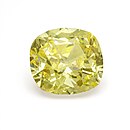
Symbolic Yellow |
| Uncle Sam | 40.23 | 12 | brown | United States | The largest discovered in the US, emerald-cut, M color (pale brown), VVS2 clarity. | — |
| Vargas diamond | 726.6 | | blue-white | Brazil | Cut into 29 smaller diamonds. | — |
| Williamson pink diamond | 54.5 | 23.6 | pink | Tanzania | Given to Queen Elizabeth II on her wedding in 1947 and later set in a brooch. "The most famous pink diamond in the world" according to the BBC.[35] | — |
| Wittelsbach-Graff Diamond | 35.56 | 31.06 | blue | India | 31.06 carats (6.212 g), Fancy Deep Blue, cushion modified brilliant.[53] Was cut down from the 35.56 Wittelsbach Blue after being purchased in 2008.[53] At the time of the sale it was the highest price ever paid for a diamond at auction.[54] | 
Wittelsbach-Graff Diamond |
| Winston Pink Legacy | | 18.96 | pink | | Fancy Vivid Pink diamond, set price record for pink diamonds of US$50.375 million on 12 November 2018 by Harry Winston after five minutes of bidding at Christie's Geneva luxury sale 13 Nov. 2018. | — |


























